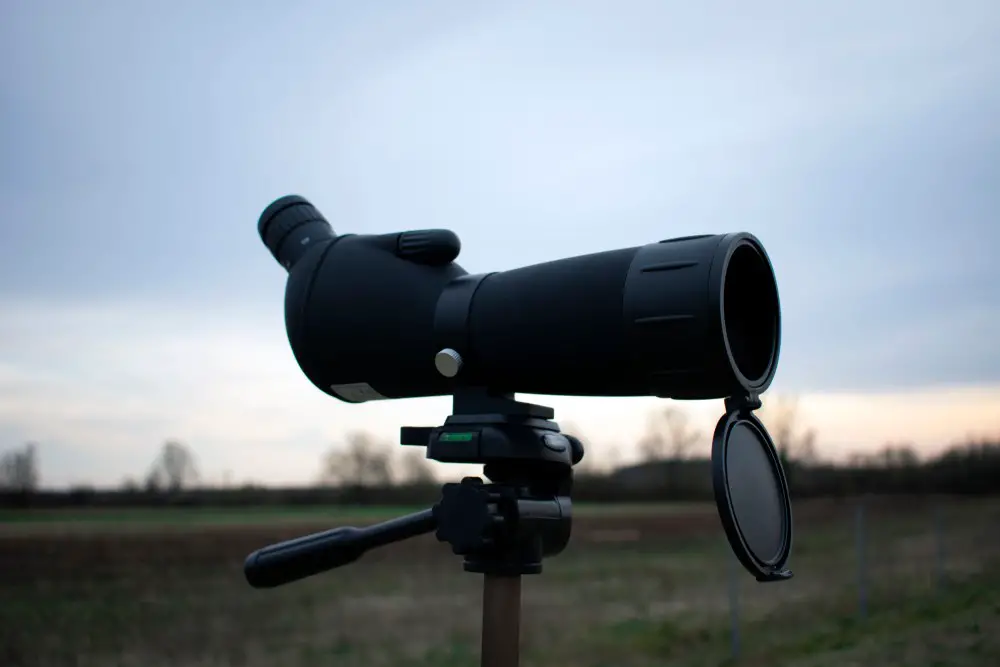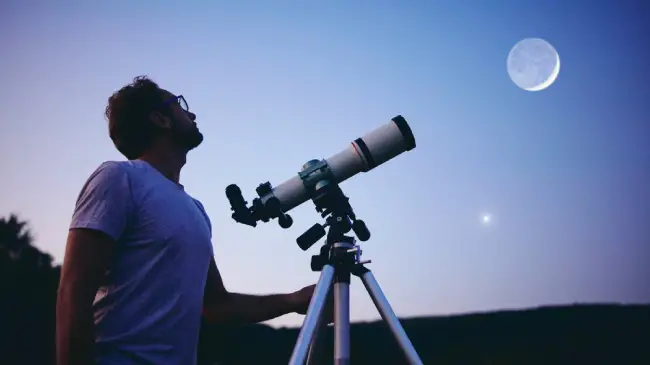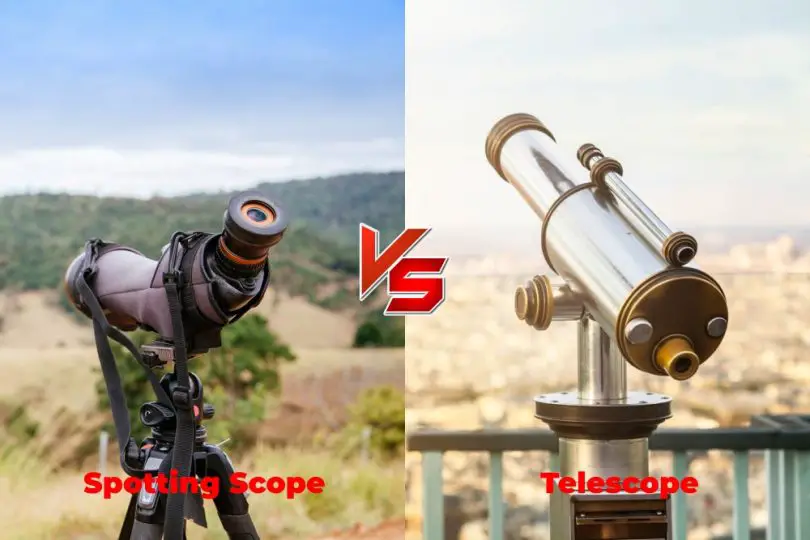The main difference between telescopes and spotting scopes is their intended use. Telescopes are primarily used for astronomical observation, while spotting scopes are designed for terrestrial (land-based) observation.
Spotting scopes have a lower magnification and a wider field of view than telescopes, which makes them better suited for observing wildlife and other objects on land. They also tend to be more compact and portable than telescopes.
On the other hand, telescopes have higher magnification and are better suited for observing distant objects in the night sky, such as stars, planets, and galaxies.
Let’s get to know more about the differences between spotting scope and telescope.
What’s a Spotting Scope?

A spotting scope is smaller and more portable than a telescope, and is designed for terrestrial observation.
Spotting scopes are often used for bird watching, hunting, and other outdoor activities. They can also be used for surveillance, and for watching wildlife or other activities from a distance.
Spotting scopes are often hand-held or mounted on a tripod or other support.
What’s a Telescope?

A telescope is typically larger and more powerful than a spotting scope, and is designed for astronomical observation. Telescopes can be used to view stars, planets, galaxies, and other celestial bodies.
They are typically mounted on a tripod or other stable base and require precise alignment to track objects in the sky.
Spotting Scope vs Telescope: How They Differ
Optics
Telescopes typically have a longer focal length and higher magnification, which allows them to magnify distant objects in the night sky, such as stars, planets, and galaxies.
Spotting scopes, on the other hand, have a shorter focal length and lower magnification, which makes them better suited for observing wildlife, birds, and other objects on land at shorter distances.
Magnifications
The magnification of a telescope or spotting scope is determined by the focal length of the lens or mirror divided by the focal length of the eyepiece. In general, telescopes have longer focal lengths and higher magnifications than spotting scopes.
For instance, a telescope with a focal length of 1000mm and an eyepiece with a 25mm focal length will have a 40x magnification (1000/25 = 40).
Spotting scopes, on the other hand, typically have shorter focal lengths, which results in lower magnifications. For example, a spotting scope with a focal length of 400mm and an eyepiece with a focal length of 20mm would have a magnification of 20x (400/20 = 20).
For spotting scopes, the magnification power range is between 15x to 60x while for telescopes, it’s 120x to 500x. However, their performances can be affected by dust particles, air currents, light pollution, and heat waves.
Applications
Telescopes are primarily used for astronomical observation. They are designed to magnify and enhance the image of celestial objects such as stars, planets, and nebulae.
Astronomical telescopes can be divided into two main categories: refractors and reflectors. Refractor telescopes use lenses to form an image, while reflector telescopes use mirrors.
They are also utilized in research, primarily in the fields of astronomy and astrophysics.
On the other hand, spotting scopes are commonly used by birdwatchers, hunters, and nature enthusiasts to observe wildlife and other outdoor activities.
They are also used by scientists, photographers, and other professionals to study and document natural phenomena.
Portability
Spotting scopes are generally more portable than telescopes because they are smaller and lighter in weight. A typical spotting scope can be handheld or mounted on a tripod, and can be easily carried in a backpack or other bag for travel.
In contrast, telescopes are typically larger and heavier, and are designed to be mounted on a tripod or other stable base. They can be difficult to move and transport, making them less suitable for travel or field use.
Image Orientation
The image orientation in a spotting scope and a telescope can be different. In a spotting scope, the image is typically right-side up and appears the same way as the object being viewed.
This is known as an “erect” image that makes these scopes more suitable for viewing objects on land, such as wildlife or buildings, because the image appears the same way as the object in real life.
In contrast, the image in a telescope can appear upside down or inverted. This is known as an “inverted” image that can make it more difficult to identify objects in the sky.
But it doesn’t affect the telescope’s ability to observe celestial objects. The upside-down image can be corrected by adding an erecting prism or diagonal mirror.
In summary, spotting scopes typically provide an erect image, while telescopes can provide an inverted image, but accessories such as erecting prisms or diagonal mirrors can be added to correct it.
Close Focus
Close focus refers to the minimum distance at which the instrument can focus on an object and produce a clear image.
Spotting scopes often have a close focus distance of around 20-30 feet, which makes them well suited for observing nearby objects such as birds or animals. They can also be used for close-up observation of flowers, insects, and other small objects.
Telescopes, on the other hand, are generally designed for observing distant objects such as stars, planets, and galaxies. As a result, they often have a much greater minimum focus distance, typically around 20-30 meters, which makes them less suitable for close-up observation.
Fields of view
Field of view (FOV) refers to the angular size of the area visible through the instrument, and is usually measured in degrees or feet at a given distance.
Between spotting scope vs telescope, the former typically have a wider field of view than the later, which allows them to capture more of the environment in a single image. This can be useful for observing moving objects, or for surveying a wide area.
However, telescopes have a narrower FOV, which allows them to magnify a smaller area to a greater degree. This makes them well suited for observing distant or faint objects, and allows for greater detail to be seen.
Price
The price range for spotting scopes can vary greatly, with lower-end models starting around $50 and high-end models reaching several thousand dollars.
Telescope price range also varies widely, with basic models starting around $100 and more advanced models costing several thousand dollars or more.
Ultimately, the cost will depend on the specific features and quality of the equipment.
Telescope vs Spotting Scopes: Advantages and Disadvantages
Spotting Scope
Pros
- Compact and more portable
- Versatile
- More affordable than telescopes
- Wider field of view for observing large areas or landscapes
- Usable for both terrestrial and astronomical observing
- Zoom eyepiece allows for more flexibility in adjusting the magnification
Cons
- Lower magnifications than telescopes
- Limited low-light performance
- Not as well suited for observing faint or distant objects
Telescope
Pros
- Much higher magnification power provides detailed views of celestial objects
- Larger aperture allows for more light gathering power and better views of faint objects
- Can be used for both astronomical and terrestrial observing
- Can be used for various types of observations, such as visual, photographic, and spectroscopic
Cons
- Can be expensive to purchase and maintain
- Requires a clear and dark sky for optimal viewing conditions
- Heavy and difficult to transport
- Requires a certain level of skill and knowledge to operate and maintain properly
- Can be affected by light pollution
FAQs
1. Can I use a spotting scope as a telescope?
Ans. A spotting scope can be used as a telescope, but it is not designed to be used in the same way as a traditional telescope. Spotting scopes are typically used for observing terrestrial objects at moderate to long distances, whereas telescopes are designed for observing celestial objects.
2. How far can I see with a spotting scope?
Ans. The maximum distance at which you can see an object with a spotting scope depends on several factors, including the magnification of the scope, the size of the objective lens, and the quality of the optics.
A spotting scope with a high magnification and large objective lens will typically have a longer maximum viewing distance than one with a lower magnification and smaller objective lens.
For example, a spotting scope with a 20-60x magnification and 80mm objective lens can have a maximum viewing distance of up to 1600 yards (1464m). However, this distance can be affected by the weather conditions, atmospheric distortion, and the size of the object you want to observe, among other factors.









Leave a Comment